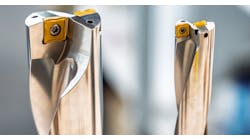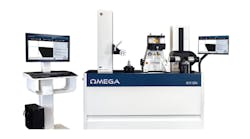Are old wives' tales holding back a productive tool?
Micrograins increased the tool life of broaches on this machine from 600 to 10,000 hits. In addition, cutting accuracy was improved.
The micrograin substrates used with this rotary broaching machine cut a wrench manufacturers production costs, letting it maintain its U.S. operation.
When making decisions concerning micrograin tungsten-carbide tooling, many shops are still relying on 10-year-old information. And what's worse is that this outdated information is based on several misconceptions: That these tools can't cut steel, that machine tools aren't ready for them, and the tools simply aren't reliable. But that's all wrong, says Duramet, a Warren, Mich.-based maker of micrograin substrates.
"Typically, and incorrectly, it was thought that straight-grade substrates couldn't be used to machine steel," says Duramet's chief metallurgist Chris James. "There was probably some truth to that with past machining centers, but with the advent of modern machining techniques and with all the new coatings, you can be quite successful using micrograins." Past problems with using these substrates to cut steel, in James' opinion, had more to do with the capability of the machine tool than the tooling.
"There wasn't a lot of R&D done as far as feeds and speeds using micrograins," James says. "It's never really been a science until recently." Additionally, machine tools have become much more precise in the past decade. Therefore, users no longer need tools with the same level of "forgiveness" a quality micrograin lacks. "Until recently, tooling was simply ahead of the machines," James explains.
Another reason micrograins didn't take off is that there simply weren't that many quality products available. Carbide producers have a difficult challenge in making a product of tung-sten-carbide grains of less than 1 µ, cobalt, and small additions of grain-growth inhibitors. "You can't just decide to make micrograins," James says. "It takes a real commitment to it, and a fairly advanced system to do it well."
At Duramet, advancements in production techniques and sintering technology let the company engineer its micrograins specifically for demanding machining environments. In addition, the company ensures its production process prevents contamination.
"Micrograins are more reliable due to sinter-hot-isostatic pressing," says Harold Borden of Spartan Carbide, a tooling manufacturer based in Roseville, Mich. "The process eliminates problems with microporosity, so the tools are much better than what they were 15 years ago."
Spartan recently used Duramet's micrograin-carbide blanks to make tooling for an end user's safety-wrench application. Previously, the end user machined the wrenches with a high-speed steel pull broach and then heat treated. However, the expansion and contraction of the heat-treating process varied, distorting wrench widths. The process also added the cost of a second deburring.
The end user's problems were addressed through a collaborative effort involving Spartan on the tooling side and Lumco Manufacturing Co., Lum, Mich., on the machine tool side. Lumco developed a rotary broaching machine that ensured the wrenches met the desired width after heat treating. The new machine tackled the user's labor and productivity issues; however, the company still had tooling issues with the brittle, heat-treated steel. Slow machining speeds, about 80 sfm, made the proper tooling vital. This is where Spartan came in.
"We needed something with a real strong edge, either a C-2 or a micrograin," says Borden. "And we also wanted a carbide that provided both wear resistance and strength. Because of the slow speeds involved, that meant a micrograin," says Borden. "And by adding a coating, we had the best of both worlds."
The micrograin substrate paid off, providing greater cutting accuracy and longer tool life. "We went from maybe 600 hits on a typical broach to up around 10,000 with the carbide," adds Borden. "The production rate is about the same, 6 or 7-sec cycles, but we get more out of the tooling and eliminate some of the post processing."
This kind of improvement demonstrates one of the key benefits of a micrograin substrate, the balance between hardness and toughness. "With any substrate, there is a trade," says James. "With greater hardness comes less ductility and vice-versa. With micrograins, you can increase hardness without the ductility problems you would have in a regular substrate. As a result, you can really push these tools."
Because of this balance, as well as better methods of producing micrograins, the application window for these substrates has grown. The result is that machinists often improve productivity while decreasing tooling costs. "One of the objectives of micrograins is to reduce the number of substrates. You don't need two or three different grades, and you don't have to figure out wich one to use." says James.
It also means the number of places micrograins are used continues to increase. "When it comes to form tools, they are excellent," says Borden. "They're used by a lot of chuckers, and in screw machines, where maybe 15 years ago they weren't applied. I think a lot of people are using micrograins in those applications where they once used high-speed steel tools."
While the use of micrograins has become popular in steel cutting, they have been used mostly for low-speed applications. As coatings continue to improve, even that may be changing.
"There are a lot of places where all I use are micrograins with a coating," says Borden. "I've had some great runs with them. If you can protect them with a coating, there's nothing like them. They hold a better edge than a steel grade, and they'll run circles around a C-5. I see there are now some coated micro-grains being used on 4140 with 500- sfm speeds. That surprises me, but they're running."
| Grade | ISO Code | WC (%) | Co (%) | Density (g/cc) | Hardness (HRA) | TRS (psi) | Applications |
| DU906 | K05, K10 | 94 | 6.0 | 14.80 | 93.0 | 505 | Offers a combination of high strength and abrasion resistance, well suited for turning and boring nonferrous, high-temperature alloys and cast iron. |
| DU908 | K10 | 92 | 8.0 | 14.65 | 92.5 | 525 | Has a high edge strength and toughness, making it a good choice for machining some steels, high-temperature alloys, cast iron, and nonferrous materials. |
| DU910 | K15, K20 | 90 | 10.0 | 14.45 | 92.3 | 580 | Refined in a special process for toughness and hardness, this grade has high edge strength and wear properties for low speeds and feeds machining steel, high-temperature alloys, and cast iron. |






